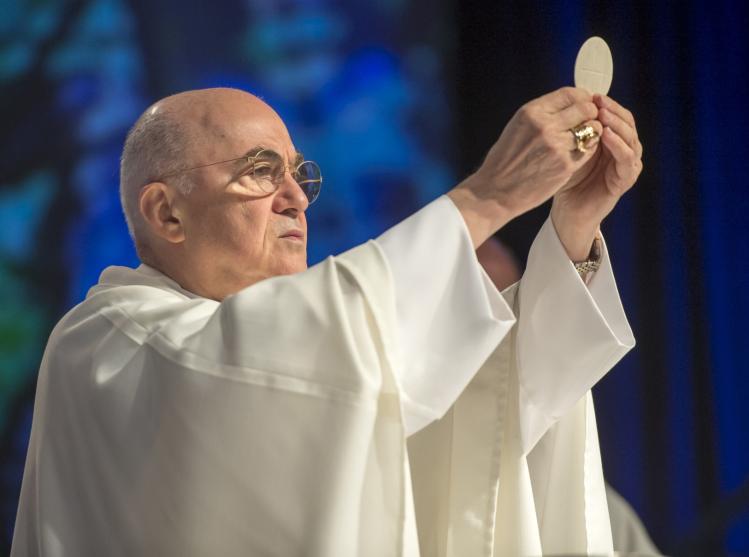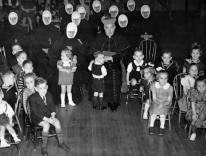
The publication of the “testimony” of Archbishop Carlo Maria Viganò, the former Vatican nuncio to the United States, is an unprecedented moment in modern church history—and not just because of his demand that Pope Francis resign. The eleven-page document, crafted and published by Viganò with the help of sympathetic Catholic journalists while the pope was in Ireland, is motivated by a personal vendetta and enabled by a serious crisis within U.S. Catholicism.
Those familiar with Viganò’s career at the Vatican and in Washington, D.C., were not surprised to see his accusations fall apart upon inspection. His earlier smear campaign against other members of the Curia, which came to light because of “Vatileaks,” had similarly collapsed. It is worth noting that the first real pushback from the Vatican came on September 2, when officials challenged Viganò’s account of how he had arranged the private meeting between the pope and Kim Davis in 2015. Viganò misled Pope Francis about that stunt, and ignored the advice of Cardinal Donald Wuerl and Archbishop Joseph Edward Kurtz, who had both warned him against it.
There is still much we don’t know about how Rome handled information about Cardinal Theodore McCarrick, but at least three things are already clear enough. First, this was not just an ordinary case of some disgruntled cleric complaining about his former boss; this was a retired papal diplomat trying to bring down the pope. Operation Viganò has failed in its purpose, and one hopes that its failure will give Francis the strength he needs to deal with the American abuse crisis the way he finally dealt with the crisis in Chile.
Second, the attempt to turn the anger of American Catholics, anger at the revelations involving former cardinal Theodore McCarrick, toward Pope Francis personally has not only failed but backfired. It has led, not very surprisingly, to a reconsideration of the role the two previous popes played in keeping McCarrick’s misconduct a secret. Francis is the first pope who not only took public action against McCarrick, but has also “accepted” the resignation of a number of bishops guilty of covering up for sexually abusive priests. It took less than a week—between August 26 and September 1—for journalists to begin filling in the real picture behind Viganò’s “testimony”: if a sexual abuser was allowed to become cardinal archbishop of Washington, D.C., it was because of what the whole ecclesiastical system under the papacies of John Paul II and Benedict XVI did and failed to do.
Third, it’s been clear from the start of this episode that it will take a long time to get to the bottom of what really happened. It is naïve to imagine that there is just one McCarrick dossier locked up in some filing cabinet in the Vatican, or even that everything is on a piece of paper somewhere. The “bishops’ factory” has always been, at least in the second millennium, a mix of bureaucracy, social mobility, and informal networks. The Vatican has never been a totally bureaucratic system, and not everything is written down.
Where are we now? This summer has inaugurated a new chapter in the history of the abuse scandal. The ecclesial context of this chapter is very different from the situation between 2002 and the pontificate of Benedict XVI. The sex-abuse crisis is now reacting explosively with another crisis: the growing rifts within the Catholic Church in the United States. There is, first, the not entirely new rift between different kinds of Catholic culture. Then there is the rift between the current pope and many American bishops, which is more recent. Finally, there is a new rift between Pope Francis and American Catholics; even those who love him can’t make out what his short-term strategy for dealing with the abuse crisis is—as opposed to the long-term fight against clericalism outlined in his “Letter to the people of God” of August 20.
Last week, in his article for the National Catholic Reporter, Michael Sean Winters had the courage to use the s-word: schism. A growing number of conservative Catholics no longer accept the pope’s legitimacy. What happened in the past few weeks exacerbated tensions that have been building for years. In truth, the people behind this attempt to force Francis to resign are a small minority of Catholics in the United States; they do not reflect Francis’s relationship with the whole U.S. church, much less the Catholic Church globally. It is unlikely, therefore, that the current crisis will lead to an open schism with two popes, two Curias, two colleges of cardinals, and two “obediences.” But the situation is complicated by the fact that there is still a pope emeritus in the Vatican. Benedict XVI has become a symbol of resistance for traditionalist Catholics who oppose Francis’s reformist papacy and see Benedict’s theology as more aligned with their own. It is too soon to say whether Viganò’s “testimony,” which unintentionally underscored serious problems with the way Benedict’s Curia dealt with charges of abuse, will end up forcing them to reconsider their uncritical allegiance to the pope emeritus. What is clear is that some have certainly tried in these past five-and-a-half years to use Benedict against Francis and to signal a different obedience, in an act of defiance against the bishop of Rome that would not have been tolerated in an earlier age.
In any case, Winters is right that there are schismatic tendencies within the U.S. Catholic Church that you don’t see elsewhere—not even in China, where the problem is the existence of two episcopal hierarchies, not two different kinds of Catholicism. Today communion is in danger here in the United States. Five centuries ago, Cardinal Robert Bellarmine, one of the most important theologians for Catholic ecclesiology, defined three bonds (vinculi) of communion with the Church: common profession of faith, communion in the sacraments, and bond to ecclesiastical authority, especially of the pope. (This definition was incorporated in paragraph 14 of Vatican II’s Lumen gentium.) Sacramental communion has been weakened by the liturgical split that followed Benedict XVI’s decision to reintroduce the pre-Vatican II Mass as an “extraordinary form” of the Roman rite. But what is really in danger is the bond between the church as a people and ecclesiastical authority—not just particular church officials, but the very idea of ecclesiastical authority.
The current crisis is really a combination of three different kinds of crisis: theological, political, and geopolitical.
The theological crisis. The attempt by traditionalists in this country to delegitimize Francis recalls the modernist controversy under Pius X in the early twentieth century, but with the roles reversed: a minority of traditionalist activists are now trying to silence a modernizing pope. But it recalls even more the “integrist” breakaway of Archbishop Marcel Lefebvre, whose excommunication latae sententiae (automatic) followed his illicit ordination of four bishops for the Society of St. Pius X. What happened in the aftermath of this split within French-speaking Catholic culture between Vatican II and 1988 may be happening now in the United States, only on a larger scale. The traditionalist quarters of U.S. Catholicism reject the development of church teaching during and after Vatican II. Their rejection is in some ways even more radical than that of Lefebvre, whose objections to Vatican II were, at least to begin with, more narrowly focused. Many traditionalists now reject the council root and branch—not just its “spirit” but also the documents issued by the council. There has been a theological polarization in the U.S. Church, each side moving in the opposite direction, so that there are now very few Catholic figures left who can build bridges between the left and the right. Certainly this generation of U.S. bishops is no longer up to the job. The lower clergy and lay men and women in positions of leadership—from parents to school teachers to liturgical ministers—will be tested very intensely over the next few months. Can they still talk with the other kind of Catholic, and teach others to do the same?
The political crisis. The rift within U.S. Catholicism, and between traditionalist Catholics and Francis, cannot be understood apart from the political polarization of America. The first phase of the problem was the growing identification of the U.S. bishops with the Republican Party, largely because of a few social issues. As the Republican Party has been radicalized in the past decade, so have more than a few bishops. During the same period, some prominent conservative intellectuals have embraced Catholicism for reasons that seem purely political. This is not a new phenomenon. It has much in common with Charles Maurras’ Action Française, a nationalist movement condemned by Pius XI in 1926. Maurras had no time for the Gospel but saw Catholicism as a useful tool for the creation of an antidemocratic social order. The new enthusiasm for an older version of Catholicism on the part of conservative intellectuals with no interest in theology also mirrors the rise of Ultramontanism in the first half of the nineteenth century. The Jesuit John O’Malley’s latest book on the theological movements that set the stage for Vatican I helps us see the many similarities between nineteenth-century Ultramontanism and early-twenty-first-century traditionalist Catholic Americanism. In both movements, the game is played mostly by journalists and other lay intellectuals whose understanding of the church is essentially political rather than spiritual. They celebrate the church as an institution that can withstand modernity, and especially the modern state. They have little or no interest in ecclesiology or sacramental theology—or anything else that cannot be easily weaponized against their political enemies.
The geopolitical crisis. The Catholic media outlets that have been an integral part of the Viganò operation want to recapture Rome but have little knowledge of Rome or, for that matter, the global church. For them, the whole Catholic Church is the American Catholic Church writ large. Philadelphia is not the new Avignon, but the United States resembles what France was for Catholicism in the fourteenth and fifteenth centuries. The Great Western Schism resulted in part from a contest for leadership of Christian Europe between the papacy and the French monarchy. There is now a tacit contest for moral leadership between the world’s last superpower and the Vatican. This is a fracture within U.S. Catholicism, but also a fracture in the global church. It is worth noting that Latin American and European bishops’ conferences have publicly supported Francis since Viganò’s letter appeared, while there has been a shocking silence on the part of most U.S. cardinals and bishops. Some conservative U.S. bishops have vouched for Viganò’s integrity, and a few Francis appointees mentioned in the letter have come to the pope’s defense, but most U.S. bishops have kept their own counsel. Their failure to support Francis can be read as a sign of their desire to have answers from Rome about McCarrick, but it can also be understood as their attempt to recover their credibility by signaling their distance from a pope that the powerful Catholic right never really accepted. It isn’t clear how the relationship between these U.S. bishops and the pope will be repaired. The bishops’ synod on young people beginning next month in Rome is technically an “ordinary synod,” but, because of its timing, it is likely to be an extraordinary moment in the life of this fractured church.
Please email comments to [email protected] and join the conversation on our Facebook page.
Previous Story
Better Dead than Disabled?
Next Story
Lady Sings the Chants
